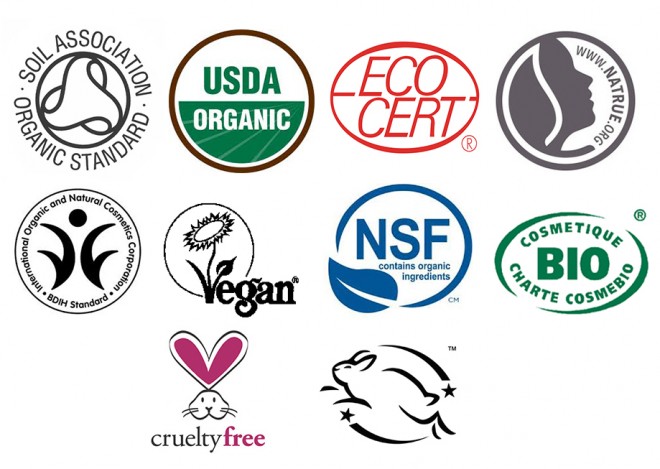 1. Soil Association (Europe, UK) – all beauty products certified by the Soil Association are checked by external auditors. However, the Association has two levels of certification: 1. ORGANIC – for a product to be labeled as organic, it must contain at least 95% organic ingredients; 2. MADE WITH ORGANIC – must contain a minimum of 70% of organic ingredients. The remaining 30% of the ingredients are also bound by strict guidelines.
1. Soil Association (Europe, UK) – all beauty products certified by the Soil Association are checked by external auditors. However, the Association has two levels of certification: 1. ORGANIC – for a product to be labeled as organic, it must contain at least 95% organic ingredients; 2. MADE WITH ORGANIC – must contain a minimum of 70% of organic ingredients. The remaining 30% of the ingredients are also bound by strict guidelines.
2. USDA Organic (USA) – this initially is a standard, established by the US Department of Agriculture to ensure the quality of food, fiber, and specialty crops. If you see the USDA Organic seal, it means your beauty product has 95% or over ingredients that are organic.
3. ECOCERT (Europe, France) – the certification issued by Ecocert is for organic farming and textiles but is also used for natural and organic cosmetics. There are two levels of certification for cosmetics: 1. NATURAL – requires 50% of the total ingredients to be of natural origin or plant-based and at least 5% of the total ingredients to be organic; 2. NATURAL & ORGANIC certification requires a minimum of 95% of the total ingredients to be of natural origin or plant-based and at least 10% of the ingredients to be organic. Animal testing and GMOs are forbidden with this certification.
4. NaTrue (Europe) – certifies natural ingredients (including water), nature-derived substances, and nature-identical substances (like minerals). NaTrue has three levels of certification: 1. NATURAL – ingredients must be natural (or natural derivative), but they do not have to be organic (from organic cultivation); 2. NATURAL WITH ORGANIC PORTION – more than 70% of natural (or natural derivative) ingredients must be from controlled organic production and/or controlled wild collection; 3. ORGANIC – more than 95% of natural (or natural derivative) ingredients must come from controlled organic cultivation and/or controlled wild collection. No animal testing is allowed with this certification.
5. BDIH (Europe, Germany) – requires manufacturers to use natural raw materials such as plant oils, fats and waxes, herbal extracts and essential oils, and aromatic materials from controlled biological cultivation or controlled biological wild collection. Being a natural cosmetics standard, BDIH requires manufacturers to use organic content wherever possible, but products made from natural raw non-organic ingredients can also be certified by this label. Animal testing is forbidden with this certification.
6. Vegan Society (Europe, UK) – vegan, animal-free standard. It appears on thousands of beauty products and is displayed by businesses that have been registered with the Society.
7. NSF (USA) – requires a minimum of 70% of all ingredients (excluding water) to be organic in order to receive this certification.
8. CosmeBio (Europe, France) – two levels of certification: 1. BIO – requires at least 95% natural ingredients or ingredients derived from natural sources, at least 95% plant ingredients produced by organic farming, and at least 10% of all product content produced by organic farming; 2. ECO – requires at least 95% natural ingredients or derived from natural sources, at least 50% of plant ingredients produced by organic farming, and at least 5% of all product content produced by organic farming. Allows up to 5% of synthetic ingredients for both levels.
9. Cruelty-free Bunny (The PETA Bunny) – pink-ear bunny means that brands either signed PETA’s statement of assurance or provided a statement confirming the fact that they do not conduct or commission any animal tests on their ingredients, formulations, or finished products, and pledge not to do so in the future.
10. The Leaping Bunny – is an official global standard that marks animal-friendly brands all around the world. The certification is managed in each region by a coalition of animal organizations. The Leaping Bunny helps customers to be sure they are buying truly cruelty-free beauty products and not the ones tested in countries that allow animal testing.


Nice post! :-)x
thank you! 🙂
Very useful! Thank you for sharing 🙂
thank you, glad you liked it 🙂
Great post! Very helpful! I am sharing this via Pinterest and Twitter!
Thank you, Amber! 🙂
Great post!! 🙂 xx
thank youuu! 🙂
Important information to convey. Your efforts are truly appreciated.
Thank you, Bella Lynn Naturals. I am happy that people find it helpful 🙂
This is a really handy post to have, thank you for sharing, I’ve bookmarked it in fact 🙂
Chesca x
Thank you, Chesca! It’s really nice to hear that the post is helpful 🙂
This is a great post:) There is so much confusion in trying to pick a perfect product for yourself when trying to be healthy:) Thanks for sharing!
It can be confusing indeed. Thank you for stopping by, Dani!